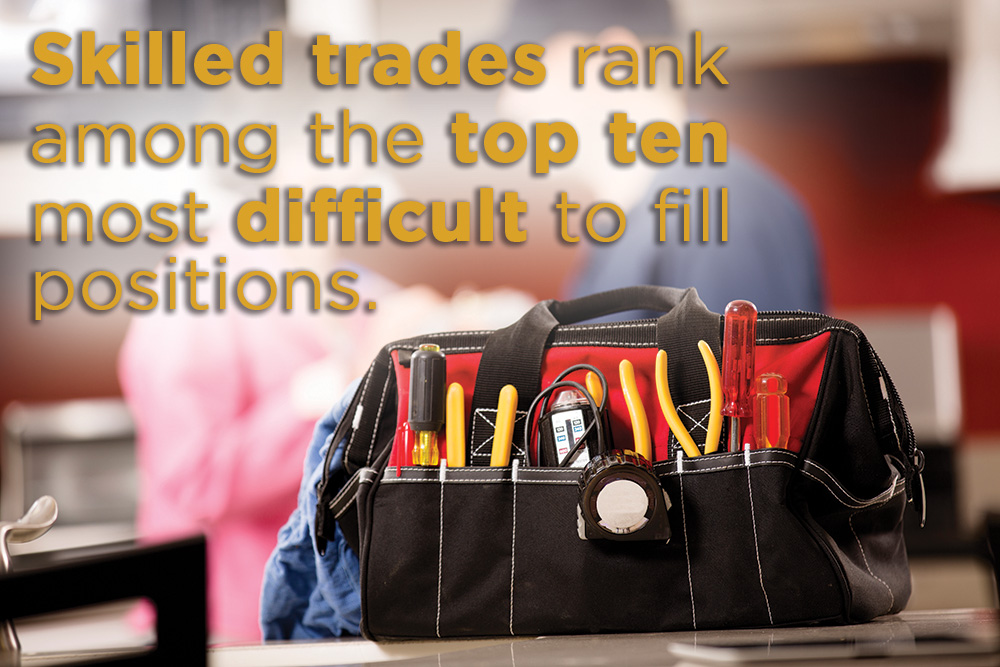The skilled trades offer a faster, less expensive route to stable, well-paying jobs, and 17.5 percent of skilled tradespeople will go on to start their own business and become self-employed – the American Dream. Despite all this, there is an anticipated shortage of plumbers, electricians and HVACR technicians as Baby Boomers continue to retire.
 The average cost of trade school is $33,000, versus a bachelor’s degree, which averages out at $127,000. Approximately 40 percent of college students drop out without a degree, and, of those who complete their degree, 64 percent take more than four years to graduate, racking up even more debt. Less than two percent of students drop out of trade school, and the longest period of education is two years, although some industries require two to three years of paid apprenticeships following schooling.
The average cost of trade school is $33,000, versus a bachelor’s degree, which averages out at $127,000. Approximately 40 percent of college students drop out without a degree, and, of those who complete their degree, 64 percent take more than four years to graduate, racking up even more debt. Less than two percent of students drop out of trade school, and the longest period of education is two years, although some industries require two to three years of paid apprenticeships following schooling.
Trade schools have strong placement programs, frequently working directly with unions and employers, and the skilled trades can’t be automated or outsourced. The median salary for electricians is $55,190; plumbers, $53,910; and HVACR technicians, $47,610. By 2026, the demand for electricians, plumbers and HVAC technicians is anticipated to increase by 9 percent, 16 percent and 15 percent, respectively.
Still, skilled trades rank among the top ten most difficult to fill positions, according to the Bureau of Labor Statistics, and 75 percent of contractors are finding it difficult to find qualified workers. Young people aren’t entering these professions, even as older tradespeople are retiring – instead, high schoolers are being encouraged to attend college, despite the softening value of a bachelor’s degree and soaring college debt, while trades are largely overlooked and underfunded.
The skilled trades are ripe for entry by young people, those in career transition and women and minorities. Although women make up 46.9 percent of the workforce in the U.S., they make up 9 percent of those in the construction industry, which includes both skilled tradespeople and unskilled labor. When limiting it to the skilled trades, estimates are between 3.4 and 6 percent.
Women’s median income in 2017 was $41,977, 20 percent lower than men’s median income, and well below that of a skilled tradesperson. However, in the skilled trades, the wage gap is much smaller, and women earn 95.7 percent of what men earn.
Minorities also are not equally represented in the skilled trades – African-Americans make up 6.2 percent of those in construction, including both skilled and unskilled labor; while Latinos were at 30.7 percent and Asians were at 2 percent.
Meanwhile, African-Americans had the highest unemployment rate nationally at the end of 2018, at 6.5 percent, followed by Latinos at 4.5 percent and Asians at 3.2 percent – all while there were skilled trade jobs that needed to be filled. This is why it is important to encourage women and minorities to enter into the skilled trades.
It’s important not only to encourage women and minorities to go into the skilled trades, but to support them once they are there. That’s why 8.3 percent of the NLC Service Line Warranty Program network contractors are women- or minority-owned businesses. With the skilled trades employment gap in mind, we also have launched our veterans hiring initiative, matching up network contractors in need of quality employees with veterans.
The skilled trades have a bright future, and the NLC Service Line Warranty Program wants to see veterans, minorities and women share in it.
Hear from some of our existing network contractors about their experience:
NLC Service Line Warranty Program partners with municipalities to educate homeowners and offer affordable protection against potentially costly service line repairs. The Program uses a network of local plumbers who have gone through background and drug screenings. The Program’s 500-seat call center is staffed 24/7/365 to answer claims calls and dispatch contractors to address homeowners’ emergencies.
The Program is provided at no cost to cities, and partner cities can receive royalties based on participation.
To find out how you can help your residents achieve peace of mind, contact us.
